Fix: Task Manager Not Opening on Windows 10
Task Manager is a system monitor program which provides information regarding the general status of your computer and the programs and processes running on it. It can be used to force close some programs/applications and take your computer out of a not-responding state.
You can also change the process priorities using this utility and display the applications/services which run on startup. This utility also displays detailed information regarding your CPU, Memory, local disks and your internet connection. It is present in almost all the versions of the Microsoft operating system. Some users reported that they were having problems while accessing the task manager. It was either not responding or they couldn’t find a way to launch it. We have listed down a number of solutions to help you with your problem.
Here are a few ways on how you can launch your task manager.
- Press Windows + R to launch the Run Type “taskmgr” in the dialogue box and press Enter.
- Right-click on the Windows icon present at the bottom left side of the screen and select “Task Manager” from the list of options available.
- Press Ctrl+Alt+Del. A new screen will come forth consisting of few options. Click on “Task Manager” from the list of options to open it.
- Press Windows + S to launch the start menu’s search bar. Type “Task Manager” in the dialogue box. Right-click on the result which comes forth and select “Run as administrator”.
Solution 1: Running the System Maintenance Troubleshooter
The System Maintenance Troubleshooter will you run your Windows maintenance tasks automatically. It will automatically detect and fix problems such as broken links, file paths or shortcuts, and even disk volume errors. We can try running it and check our problem gets fixed.
- Press Windows + S to launch the start menu search. Type “maintenance” in the dialogue and select the first result which comes forth.

- Once the maintenance tab has been opened, click on the Maintenance heading to expand the drop down. Then select Start Maintenance present under the option of Automatic Maintenance.

- After you click it, Windows will start your maintenance and inform you of any missing or broken links to shortcuts or errors of any sort.
- Restart your computer for the changes to take place. If this still doesn’t fix anything, refer to the next solution.
Solution 2: Creating another account in Windows 10
It is possible that the problem you are facing is because of some error in your profile or the administrator hasn’t granted you access. We will cover how to edit the registry to enable the access of the task manager in your account if you are using a limited one. If you are the owner of this computer and still couldn’t access the task manager, we can try making a new local account and checking if this fixes anything.
- Open an administrator account. Type Settings in the start menu dialogue box and click on Accounts.
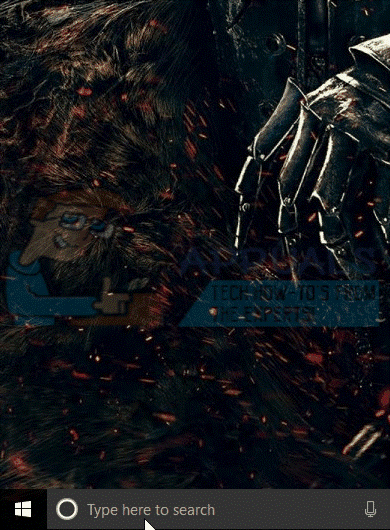
- Now click “Family and other users” options present at the left side of the window.
- Once inside select the menu, select “Add someone else to this PC”.
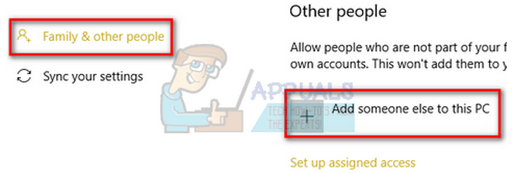
- Now Windows will guide you through its wizard on how to create a new account. When the new window comes forth, click “I don’t have this person’s sign-in information”.
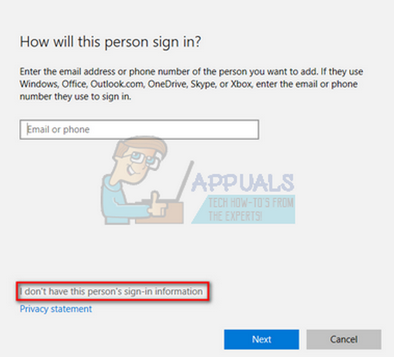
- Now select the option “Add a user without Microsoft”. Windows will now prompt you to make a new Microsoft account and display a window like this.
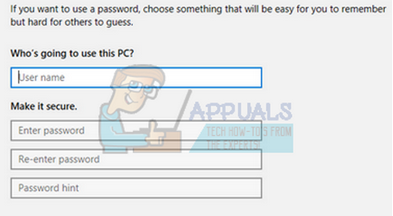
- Enter all the details and choose an easy password which you can remember.
- Now navigate to Settings > Accounts > Your Account.
- At the space beneath your account picture, you will see an option that says “Sign in with local account instead”.
- Enter your current password when the prompt comes and click Next.
- Now enter username and password for your local account and click on “Sign out and finish”.
- Now you can easily switch to a new local account, and move all your personal files to it without any barriers.
- Now navigate to Settings > Accounts > Your Account and select the option “Sign in with a Microsoft Account instead”.

- Enter your username and password and click Sign in.
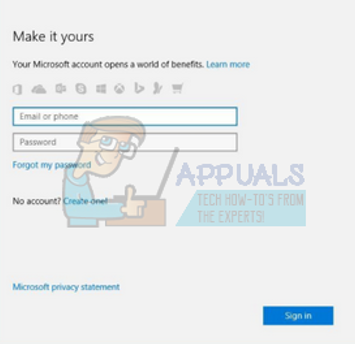
- Check if the task manager is working on this account. If it is, you can safely delete the older account and continue using this one.
Solution 3: Running System File Checker
If the solutions mentioned above don’t produce any results, we can try running the system file checker. System File Checker (SFC) is a utility present in Microsoft Windows which allows the users to scan their computers for corrupt files in their operating system. This tool has been there in Microsoft Windows since Windows 98. It is a very useful tool for diagnosing the problem and checking if any problem is due to corrupt files in windows.
We can try running SFC and see if your problem gets solved. You will get one of the three responses when running SFC.
- Windows didn’t find any integrity violations
- Windows Resource Protection found corrupt files and repaired them
- Windows Resource Protection found corrupt files but was unable to fix some (or all) of them
- Press Windows + S to launch your start menu’s search bar. Type command prompt in the dialogue box. Right-click on the application which returns as a result and select “Run as Administrator”.

- Type the following commands:

- The process might take a while as Windows is checking all your files and looking for discrepancies. Wait till the process is completely finished. Once it has finished and there were errors detected, restart your computer and check if the problem got fixed.
Solution 4: Enabling Task Manager using the Registry
We can check if your task manager is disabled by the computer’s administrator or by a virus from your registry settings. Note that Windows Registry is a powerful tool and making modifications in data entries you don’t know about could damage your PC. Be extra careful and follow the steps carefully.
- Press Windows + R to launch the Run application, type “regedit” in the dialogue box and press Enter.
- Once in the registry editor, navigate to the following file path using the left navigation pane:
HKEY_CURRENT_USER\Software\Microsoft\Windows\Current Version\Policies\System
- If the system isn’t there, you will have to create it. We will show you how to create the entire registry after this.
- Locate “DisableTaskmgr” from the list of items present. Double click it and enter the value as 0. Press Ok.
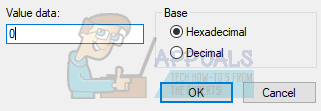
- Restart your computer and check if the problem gets solved.
If you don’t have the registry present and the file path only goes till Policies, we can try creating the registry and implementing the changes needed.
- Navigate to
HKEY_CURRENT_USER\Software\Microsoft\Windows\Current Version\Policies
- Right-click on the Policies and select New > Key.

- Name the new key as “System” and press Enter to implement the changes.
- Once in System, right-click on the empty space present at the right side of the window and select New > DWORD (32-bit) Value

- Name the new DWORD as “DisableTaskMgr” and set its value as 0.
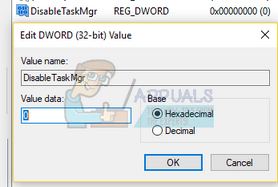
- Save changes and exit the editor. You might need to restart your computer in order for the changes to take place.
Solution 5: Enabling Task Manager using the Group Policy Editor
Group Policy Editor is a utility in Microsoft Windows which allows you to edit the local policy settings. It can be used to enable the task manager if it is disabled.
- Press Windows + R to launch the Run application. Type gpedit.msc in the dialogue box and press Enter.
- Now navigate to the following path using the navigation pane present at the left side of the screen.
User Configuration>Administrative Templates>System>Ctrl+Alt+Del Options
- On the right side of the screen, you will see an entry named as “Remove Task Manager”. Double-click it to open its settings.

- Now set the setting as Enabled and click on Apply. Now select Not Configured or Disabled and press Apply. The final value is Not Configured/Disabled. We selected Enabled and applied changes so the group policy can overrun any settings done by any external application or malware. Press Ok to save changes and exit. You might need to restart your computer in order for the changes to take place.
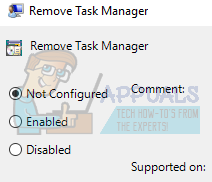
Check if the task manager opens as expected.
Solution 6: Scanning for Malware
Sometimes, this unusual behavior is caused by malware or virus present in your machine. They have special scripts that run in the background which may be extracting your data or making changes to the settings.
Scan your computer using your antivirus utility and ensure that your PC is clean. If you don’t have any specific antivirus utility installed, you can use the Windows Defender utility and scan.
- Press Windows + S to launch the start menu’s search bar. Type “Windows Defender” and open the first result which comes forward.

- At the right side of the screen, you will see a scan option. Select the full scan and click on Scan This process might take some time as Windows scans all of your computer’s files one by one. Be patient and let the process complete accordingly.
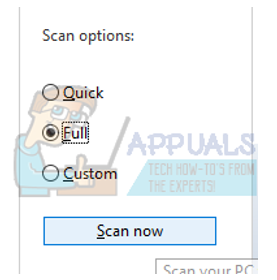
- If there was malware present on your computer, let the utility remove and restart your computer before launching the task manager.
Solution 7: Restoring your system
If all the above methods don’t work, we can try restoring your system to the last system restore point. Save all your work correctly and back up any important data. Do note that all the changes to your system configurations after the last restore point will be removed.
- Press Windows + S to launch the start menu’s search bar. Type “restore” in the dialogue box and select the first program which comes in the result.

- One in the restore settings, press System Restore present at the beginning of the window under the tab of System Protection.
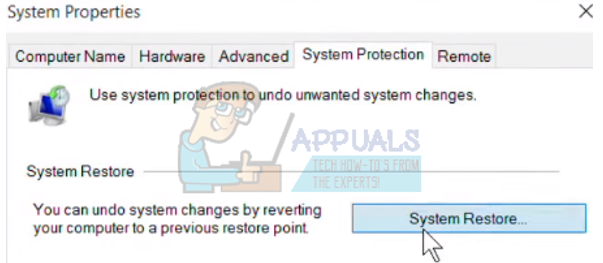
- Now a wizard will open navigating you through all the steps to restore your system. Press Next and proceed with all the further instructions.
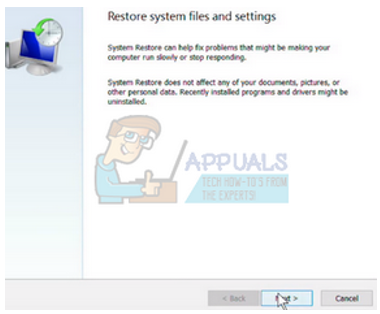
- Now select the restore point from the list of options available. If you have more than one system restore points, they will be listed here.

- Now windows will confirm your actions for the last time before it starts the system restore process. Save all your work and backup important files just in case and proceed with the process.

- Once you have successfully restored your computer, switch to tablet mode and then back to Desktop mode. Note: If you have a regular computer and don’t have the tablet mode, don’t worry. Proceed with the next instructions.
- Now try launching the task manager. You can launch it through a number of ways as explained beginning of the article.
Solution 8: Install the latest Windows updates
Windows roll out important updates targeting the bug fixes in the operating system. If you are holding back and not installing the Windows update, we strongly recommend that you do. Windows 10 is the latest Windows operating system and new operating systems take a lot of time to get perfect in every regard.
There are a lot of issues still pending with the OS and Microsoft rolls out frequent updates to target these issues.
- Press the Windows + S button to launch your start menu’s search bar. In the dialogue box type “Windows update”. Click the first search result which comes forward.

- Once in the update settings, click on the button which says “Check for updates”. Now Windows will automatically check for updates available and install them. It may even prompt you for a restart.
- After updating, check if your issue got fixed.